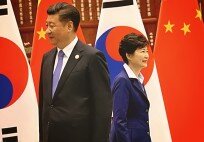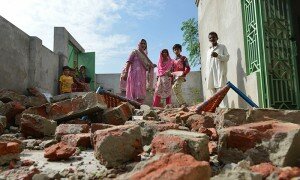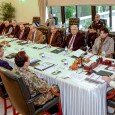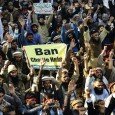By Dr. Hasan Askari Rizvi –
Indian violations of the Line of Control (LoC) and Working Boundary: Prime Minister Nawaz Sharif’s strong desire to cultivate cordial political and economic relations with India has come in clash with the harsh manifestation of India’s new policy of risk taking
The relations between Pakistan and India are traditionally known for mutual distrust, bilateral disputes and problems, clashes in Kashmir and wars. They also engage in negative propaganda against each other. There have also been periods of relative calm and cordiality, diplomatic arrangements for handling a number of bilateral issues and avoidance of propaganda wars. However, if we take the aggregate of their bilateral relations over the last 67 years, the balance is decisively tilted towards the former description of their relations, i.e., troubled and problematic.
In August-October 2014, the bilateral relations between Pakistan and India plunged to a very low, marked by strong negatives and hostility. The current degeneration process started in August, although fears were expressed on advent of Narenedra Modi to power in India on May 26, 2014 that their relations would plunge to a crisis situation after his government settled down.
The optimists thought that Pakistan’s Prime Minister Nawaz Sharif’s participation in Modi’s swearing-in ceremony in Delhi would restrain the new Indian government from pursuing a strident approach towards Pakistan, at least for the time being. This optimism proved short-lived.
The Latest Crisis
The Modi government agreed to hold the Foreign Secretary level talks on August 25, 2014, to explore the option of reviving the dialogue suspended in January 2013. However, on August 18, 2014, India cancelled the meeting in protest against the meeting of Pakistan’s High Commissioner (Ambassador) in New Delhi with a Kashmiri leader, Syed Shabbir Shah, a couple of hours earlier. India’s Ministry of External Affairs described this meeting as an attempt “to interfere in India’s internal affairs.” On August 19, Pakistan’s High Commissioner held meetings with three more Kashmiri leaders.
India’s objection reflected a new tough mood because this was not the first time that any Pakistan’s High Commissioner had met with Kashmiri leaders. Such meeting took place from time to time in the past. On September 29, Pakistan’s Advisor to the Prime Minister on National Security and Foreign Policy, Sartaj Aziz, attempted to defuse the situation by describing the meeting between the High Commissioner in Delhi and Kashmiri leaders as somewhat ‘ill-timed’.
The cancellation of the Foreign Secretary level talks was followed up by India by escalating armed clashes on the Line of Control (LoC) in Kashmir that divided Kashmir and the Working Boundary that separated the Jammu area of Kashmir from the Sialkot area in mainland Pakistan. The clashes between the security forces of India and Pakistan on the LoC or on the Working Boundary became intense in September-October. It became an almost daily occurrence on the Working Boundary in the month of September. There were human and material losses on both sides. The Director General of Military Operations (DGMO) of India and Pakistan talked to each other on the ‘hotline’ — a telephone connection between the army headquarters of both countries — on October 14 to defuse the situation but the situation on the Working Boundary did not change. The security forces of India and Pakistan exchanged fire even on the day the two DGMOs talked to each other.
Historical Backdrop
The relations between Pakistan and India deteriorated with the Kargil War (May-July 1999) and the visit of President General Pervez Musharraf to India in July 2001 for talks at Agra with India’s Prime Minister Atal Behari Vajpayee failed to initiate the dialogue process on the contentious issues. Their relations deteriorated further when India blamed Pakistan for the terrorist attack on Indian Parliament on December 13, 2001. By the end of December, India mobilized its troops to Pakistan border and severed all road and air traffic between the two countries and trade was also suspended. The troops of the two countries maintained an eye-ball to eye-ball confrontation between January-October 2002, when India decided to recall its troops gradually from the Pakistan border. Pakistan responded by pulling back its troops.
It was in 2003 that Indian Prime Minister Vajpayee and Pakistan’s President Pervez Musharraf showed flexibility in their policies and agreed to explore new ideas for solution of their bilateral problems. This paved the way for Vajpayee’s visit to Islamabad for the SAARC Summit in the first week of January 2004. The two leaders met on the sidelines of the SAARC summit and agreed to start a dialogue on 8 issue areas, including Kashmir and terrorism.
Despite the change of government in India after the general elections in May 2004 and assumption of the office of Prime Minister by Dr. Manmohan Singh, the dialogue process was formally launched. This process helped to improve their relations and created the hope that they might resolve most bilateral problems. This process was disrupted twice when India suspended it temporarily. This dialogue process broke down after the terrorist attack in Mumbai in November 2008 because India refused to continue with the dialogue process.
The dialogue process was revived in March 2011 and they held bilateral meetings on all contentious issues but they could not move close to solution of any issue with the exception of trade.
India and Pakistan decided to expand trade and Pakistan agreed to give the Most-Favored Nation (MFN) status to India by the end of 2012. This did not happen because of bureaucratic opposition on both sides and India’s non-tariff barriers to the disadvantage of Pakistani trade. Pakistan floated the notion of Non-Discriminatory Market Assess (NDMA) instead of the MFN status to India. Even this could not materialize because of the non-resolution of the issue of non-tariff barriers and an increased opposition in Pakistan to granting NDMA status to India because of the stepped-up violence on the LoC in 2013.
While the progress of the dialogue process was painstakingly slow, the firing incidents began to take place more frequently in December 2012-January 2013. It was on November 26, 2003 that India and Pakistan agreed to ceasefire on the LoC. Peace was maintained on the LoC for 2003-2012. There were occasional ceasefire violations which the local commanders used to resolve quickly.
There were several ceasefire violations in January-February 2013. In January 2013, India blamed Pakistan of beheading one of the two soldiers killed by its firing in Indian-Kashmir territory. Pakistan rejected the charge because beheading an Indian solider meant that Pakistani troops crossed into Indian Kashmir and then did that. No LoC crossing by Pakistani soldiers well into Indian-Kashmir was reported.
India postponed the talks between the Water and Power Secretaries scheduled for January 28. Later, the whole dialogue process, including the talks for expansion of the existing trade, was suspended. The bilateral trade under the earlier arrangements continued.
Since January 2013, the security forces of India and Pakistan have been exchanging fire from time to time. The general pattern was that such firing took place for a couple of weeks and then it died down. It recurred after some days or weeks. The exchange of fire on the LoC and especially on the Working Boundary became more intense and persistent since the cancellation of the Foreign Secretary level talks on August 18, 2014. Both sides suffered losses in terms of human life and property. India blamed Pakistan for starting the fire. Pakistan held India responsible for the violence.
India’s New Approach
What has been happening on the Line of Control and especially on the Working Boundary is not accidental but a part of the Modi government’s new policy of playing tough with Pakistan in order to punish Pakistan for its policies that conflict with India’s security concerns and its vision of its global and regional role.
It is noteworthy that the latest exchange of fire is taking place on the Working Boundary between the Jammu region of Indian-administered Kashmir and Pakistani territory. India is using Kashmiri territory to attack Pakistani areas and cause damages there. However, this cannot be described as the violation of international border between India and Pakistan.
India has resorted to these methods as a punitive action with the conviction that Pakistan would not escalate it to a full-fledged war. This calculation is based on the assumption that the Pakistan Military is fully engaged in the security operations in North Waziristan and other tribal areas. Further, Pakistan is devoting more attention to the security arrangements on the Pakistan-Afghanistan border because of the U.S./NATO drawdown by the end of 2014. India’s military and national security authorities do not expect Pakistan to undertake any major shift of its military forces from these areas to Kashmir and the Pakistan-India border in the near future or escalate the current skirmishes on the LoC and the Working Boundary.
This is also a part of the BJP effort to strengthen its electoral position in the forthcoming elections in Kashmir. It has already won state-level provincial elections in Haryana and Maharashtra in October 2014 by ousting the Congress Party. The BJP wants to perform in the forthcoming Kashmir elections. Jammu and other non-Muslim areas of Kashmir are the focus of its attention. The BJP leadership expects that a hard-line towards Pakistan will help to win elections in these areas. Prime Minister Narendra Modi has undertaken two visits to Kashmir since he assumed office in the last week of May 2014.
The strident approach towards Pakistan is also a manifestation of new RISK taking by the Indian Army and the current government’s national security establishment led by Ajit Doval and his close associates. They have put together a “punitive action” approach towards Pakistan because Modi has temporarily yielded space to the Army and national security establishment for dealing with Pakistan.
As a matter of fact, the Indian Army and the Delhi-based security experts have been exploring options since the Mumbai terrorist attack in November 2008 to take some punitive military measure against Pakistan that would not escalate to full war. They explored various options during the last 5-6 years which included a limited war, air-strikes on so-called terrorist camps in Pakistan, and the “Cold-Start” strategy. They also strengthened the policy of financial support to dissident Baloch groups and selected Pakistani Taliban for encouraging them to resort to violence inside of Pakistan.
However, Manmohan Singh did not agree with the suggestion of any direct punitive military action against Pakistan because of the risk of escalation by Pakistan.
India’s current Army leadership and Modi’s national security establishment have decided to take the risk of limited military action against Pakistani territory from the Jammu area of Kashmir. This shows the increased role of the Indian Army in India’s Kashmir and Pakistan policy with the support of the civilian national security establishment and the hardliners in the BJP. The previous Army Chief who retired on July 31, 2014 advocated playing tough with Pakistan and the incidents on the LoC increased during his tenure but Dr. Manmohan Singh and his civilian advisors played a restraining role. Now, the current Army Chief and the National Security establishment are riding high.
The Modi government is encouraged in its current anti-Pakistan disposition because of the U.S. support to its position on terrorism emanating from Pakistan. The joint statement after the Modi-Obama meeting in Washington D.C. on September 30, 2014 specifically named some Pakistan based militant groups as the target of joint U.S.-India efforts. In a separate statement, the U.S. named a Pakistani militant leader as a terrorist and identified two Pakistan based militant groups as terrorist organizations. India is now using the argument that India is taking action against a country that supports terrorists groups and that it is countering Pakistani attacks in Kashmir because Pakistan is attempting to induct terrorists into Indian Kashmir.
Pakistan’s paramilitary and regular troops are engaged in countering Indian violation of the LoC and the Working Boundary. However, the civilian government’s response took time to shape up. Prime Minister Nawaz Sharif’s strong desire to cultivate cordial political and economic relations with India came in clash with the harsh manifestation of India’s new thinking. Initially the federal government expected that the incidents on the LoC will stop after a week or so. However, as the situation deteriorated on the LoC Pakistan’s Foreign Office became active in launching diplomatic offensive in and outside the United Nations. It also approached the governments of the European countries and the U.S. for mobilizing support for its stand on the military skirmishes in Kashmir and its perspective on the Kashmir problem.
The international community is concerned about the possibility of escalation of the current limited engagement to a full war. These governments are endeavouring to restrain the two sides and advising them to opt for political dialogue. However, none is interested in using its leverage for advising India to resolve some of the problems with Pakistan. They want India and Pakistan to stop fighting and resume the suspended dialogue. These skirmishes may end but their negative fall-out and India’s current disposition of “Punish Pakistan” will make it difficult for Pakistan and India to resolve some, not to speak of all, problems in the near future.
The writer is a prominent political and security analyst































































































